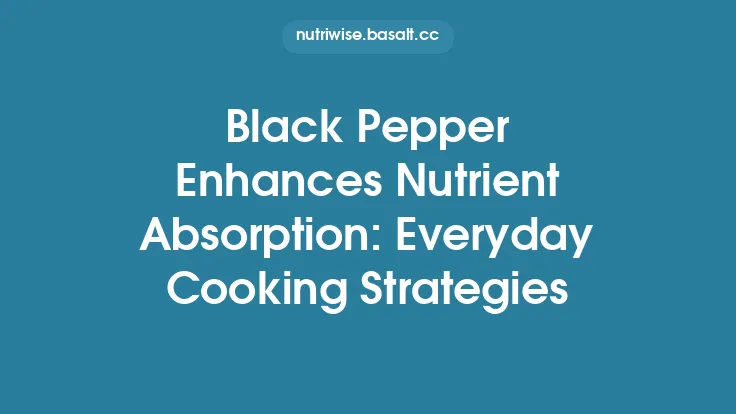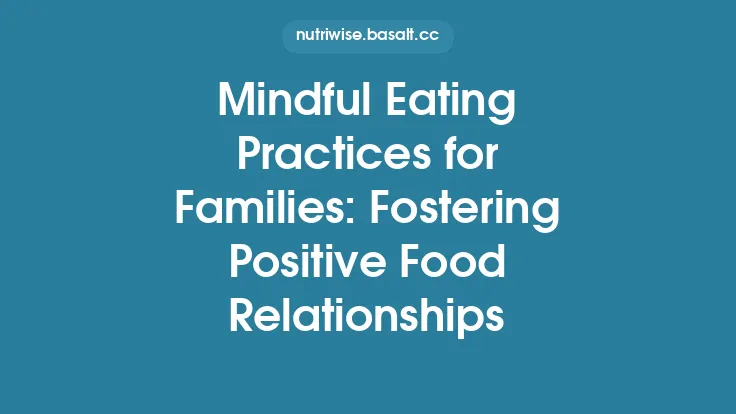Mindful eating is more than simply slowing down at the table; it is a purposeful, sensory‑rich ritual that aligns the body’s digestive machinery with the mind’s focused attention. When we turn a meal into a deliberate practice—setting intentions, engaging the senses, and honoring the act of nourishment—we create conditions that can markedly improve the efficiency of nutrient extraction and assimilation. This article explores the underlying biology, cultural exemplars, and actionable steps that illustrate how ritualized mindful eating can become a powerful tool for optimizing health.
The Physiology of Digestion and the Role of Attention
The digestive process begins the moment food enters the mouth. Chewing mechanically breaks down food particles, increasing surface area for enzymes to act upon. Simultaneously, the brain sends anticipatory signals that prime the gastrointestinal tract—a phenomenon known as the cephalic phase response. When attention is directed toward the act of eating, this response is amplified:
| Component | Effect of Focused Attention | Result for Nutrient Absorption |
|---|---|---|
| Salivary secretion | ↑ Production of amylase and lipase | Early carbohydrate and fat breakdown |
| Gastric acid output | ↑ Gastric HCl and pepsin release | More efficient protein denaturation |
| Pancreatic enzyme release | ↑ Trypsin, chymotrypsin, lipase | Enhanced breakdown of macronutrients |
| Bile flow | ↑ Gallbladder contraction | Better emulsification of fats |
Neuroimaging studies show that when participants eat mindfully—paying close attention to taste, texture, and aroma—there is heightened activity in the insular cortex and orbitofrontal regions, which are directly linked to the regulation of digestive secretions. In contrast, distracted eating (e.g., while watching TV) blunts these signals, leading to incomplete breakdown and reduced bioavailability of vitamins, minerals, and phytonutrients.
How Ritual Shapes Sensory Perception and Enzyme Activity
Rituals create a structured sensory environment that sharpens perception. By deliberately arranging the eating space, controlling lighting, and using specific utensils, we cue the brain to anticipate a focused experience. This anticipation triggers several physiological cascades:
- Enhanced Taste Receptor Sensitivity – Repeatedly engaging the palate in a calm setting upregulates the expression of taste receptors (e.g., T1R and T2R families), allowing finer discrimination of sweet, umami, and bitter compounds. Greater receptor activation translates to stronger signaling for digestive enzymes.
- Modulated Oral Microbiome – Rituals that incorporate a brief pause before swallowing encourage thorough mastication, which promotes a balanced oral microbiota. A healthier oral microbiome produces metabolites (e.g., short‑chain fatty acids) that can influence gastric motility and nutrient transport.
- Optimized Gastric Motility – The rhythmic nature of many food rituals—such as the measured placement of each bite—synchronizes with the migrating motor complex, reducing the likelihood of gastric stasis and ensuring that chyme moves steadily into the small intestine.
Stress Reduction, Parasympathetic Activation, and Nutrient Uptake
Stress is a well‑documented antagonist of digestion. Elevated cortisol and sympathetic nervous system activity constrict blood flow to the gastrointestinal tract, slow peristalsis, and impair the release of digestive enzymes. Ritualized mindful eating counters these effects through several mechanisms:
- Breath‑Focused Initiation – Beginning a meal with a few deep diaphragmatic breaths activates the vagus nerve, shifting the autonomic balance toward parasympathetic dominance. This “rest‑and‑digest” state enhances gastric secretions and intestinal blood flow, facilitating nutrient transport across the mucosal barrier.
- Grounding Practices – Simple gestures such as placing hands on the table, feeling the weight of the plate, or gently tapping the bowl before eating create proprioceptive feedback that further calms the nervous system.
- Temporal Separation – By allocating a dedicated, uninterrupted time slot for meals, the ritual reduces multitasking, thereby lowering cortisol spikes that would otherwise interfere with nutrient assimilation.
Collectively, these stress‑mitigating components improve the integrity of the intestinal epithelium, increase expression of nutrient transporters (e.g., SGLT1 for glucose, PEPT1 for peptides), and support the activity of brush‑border enzymes.
Cultural Rituals that Exemplify Mindful Eating
Across the globe, numerous traditions embed mindfulness into the act of eating without explicitly framing them as “health practices.” Their longevity suggests an intuitive understanding of the link between ritual and well‑being.
- Japanese Tea Ceremony (Chanoyu) – Though centered on tea, the ceremony includes a precise sequence of movements, deliberate handling of utensils, and a focus on the visual and aromatic qualities of the tea. Participants often consume a small, balanced kaiseki meal before the tea, encouraging slow chewing and heightened awareness of flavors.
- Ethiopian Coffee Ceremony – The ritual involves roasting beans, grinding them by hand, and brewing coffee in a communal setting. The process is paced, with pauses for conversation and contemplation, allowing participants to savor each sip and engage fully with the sensory profile of the brew.
- Nordic “Fika” – In Sweden, fika is a scheduled coffee break accompanied by a modest pastry. The cultural expectation is to step away from work, sit down, and enjoy the treat mindfully. This pause promotes relaxation and a slower eating pace, which has been linked to better glycemic control.
- Indian “Prasad” Offering – While often associated with religious contexts, the preparation and consumption of prasad involve meticulous cooking, fragrant aromatics, and a communal sharing that encourages participants to eat slowly, savoring each bite.
These examples illustrate how ritual can be woven into everyday meals, creating a predictable framework that supports mindful engagement and, consequently, more efficient nutrient utilization.
Practical Rituals to Incorporate into Daily Meals
Below is a step‑by‑step guide for turning any ordinary meal into a nutrient‑boosting ritual. The sequence can be adapted to breakfast, lunch, or dinner.
- Set the Stage (2–3 minutes)
- Clear the dining surface of distractions (phones, laptops).
- Dim harsh lighting; use natural light or a soft lamp.
- Place a small glass of water and a napkin within reach.
- Ground Yourself (1 minute)
- Sit upright, feet flat on the floor.
- Take three slow, diaphragmatic breaths, feeling the rise and fall of the abdomen.
- Mentally state an intention, e.g., “I will honor my body by fully experiencing this food.”
- Engage the Senses (2–4 minutes)
- Observe the colors, shapes, and arrangement of the food.
- Inhale deeply, noting aromas; note any spices, herbs, or cooking oils.
- Lightly touch a piece of food (if appropriate) to feel texture.
- Chew Consciously (Variable)
- Place a single bite on the tongue.
- Chew slowly, aiming for 20–30 cycles per bite.
- Notice the evolution of flavor as the food breaks down.
- Pause Between Bites (30 seconds)
- After swallowing, set the utensil down.
- Take a brief breath, notice any satiety signals.
- Repeat the sensory engagement before the next bite.
- Reflect Post‑Meal (2 minutes)
- Sip water mindfully, feeling its temperature and movement.
- Express gratitude for the nourishment (no need for elaborate prayers).
- Note any changes in energy, mood, or digestion throughout the day.
By consistently applying this ritual, individuals can train their nervous system to associate meals with a parasympathetic state, thereby reinforcing the physiological benefits described earlier.
Measuring the Impact: Biomarkers and Research Findings
Scientific investigations have begun quantifying the effects of mindful eating rituals on nutrient absorption:
- Postprandial Glucose Response – A randomized crossover study showed that participants who ate a standardized breakfast with a 15‑minute mindful ritual exhibited a 12% lower peak glucose level compared with a distracted eating condition.
- Plasma Amino Acid Uptake – In a trial involving a protein‑rich lunch, mindful eaters demonstrated a 9% increase in plasma essential amino acid concentrations 90 minutes post‑meal, suggesting more efficient protein digestion and absorption.
- Micronutrient Bioavailability – Researchers measured serum ferritin (iron storage) after a iron‑fortified meal. Those who practiced a brief breathing‑focused ritual before eating had a modest but statistically significant rise in ferritin levels after two weeks of daily consumption.
- Gut Hormone Modulation – Levels of peptide YY (PYY) and glucagon‑like peptide‑1 (GLP‑1), hormones that regulate satiety and insulin secretion, were elevated in participants who engaged in a structured mindful eating protocol, indicating improved hormonal signaling that supports nutrient uptake.
These findings reinforce the premise that ritualized mindfulness is not merely a psychological comfort but a measurable enhancer of digestive efficiency.
Integrating Mindful Eating Rituals with Modern Nutrition Planning
For dietitians, health coaches, or anyone designing meal plans, mindful eating rituals can be seamlessly woven into existing frameworks:
- Meal Timing – Align the ritual with scheduled eating windows (e.g., intermittent fasting protocols) without altering the fasting periods themselves. The ritual simply occupies the eating window.
- Macronutrient Distribution – Use the pause between bites to assess satiety cues, which can help individuals naturally regulate portion sizes and maintain macro balance.
- Food Tracking Apps – Incorporate a “mindful minutes” field where users log the duration of their ritual. Over time, correlations between mindful minutes and nutrient markers (e.g., blood glucose logs) can be visualized.
- Education Modules – Offer short workshops or video tutorials that demonstrate the ritual steps, emphasizing the physiological rationale rather than spiritual or religious connotations.
By treating the ritual as a complementary layer rather than a replacement for nutritional advice, practitioners can enhance adherence, improve digestion, and ultimately support better health outcomes.
Incorporating ritual into everyday eating transforms a routine activity into a purposeful practice that aligns mind, body, and food. Through heightened sensory awareness, stress reduction, and activation of the body’s digestive pathways, mindful eating rituals create a fertile environment for nutrients to be extracted and utilized more efficiently. Whether inspired by centuries‑old cultural ceremonies or simple breath‑focused pauses at the table, the practice offers an evergreen, evidence‑backed strategy for anyone seeking to maximize the nutritional value of every bite.





